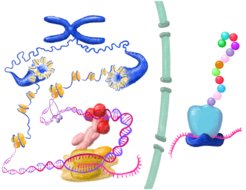Understanding cell functions: New CRC combines life sciences and polymer research
DFG Approves New Collaborative Research Center 1551 "Polymer Concepts for Understanding Cellular Functions
Molecular processes that take place in cells are to be better understood with the help of polymer research. This is the goal of a new Collaborative Research Center that has been approved by the German Research Foundation (DFG). The SFB 1551, entitled "Polymer Concepts for Understanding Cellular Functions," will start in January 2023 as a collaboration between the Max Planck Institute for Polymer Research, Johannes Gutenberg University Mainz (JGU), the Institute of Molecular Biology (IMB), the Max Planck Institute for Biophysics and the University of Stuttgart. In particular, the participating scientists will investigate the polymeric construction of DNA, RNA, proteins and synthetic model compounds and analyze the influence of the polymeric properties as well as the interaction of these biomolecules on cell function. The DFG is providing around 9.5 million euros for this purpose over the first four years.
Focus on polymer properties of DNA, RNA and proteins

Polymers are molecules that are made up of many, often identical, building blocks, such as plastics. But the genetic substance DNA, RNA as a transporter of genetic information, and proteins, which are formed on the basis of genetic information, also have a polymeric construction. "We want to analyze the polymer properties of DNA, RNA and proteins in order to understand their interaction at the biological level," explains Prof. Dr. Edward Lemke of JGU, the spokesman for the new collaborative research center. "To this end, we have formed strong teams composed of researchers from the life sciences and polymer research." Big tasks await them: A human cell consists of RNA for 20 percent of its dry mass, and DNA, in turn, is densely packed into a cell nucleus of 10 micrometers in diameter with a length of two meters - and can still be read and copied.
Gap in understanding cell function of biopolymers to be closed
Until now, the polymeric nature of these macromolecules has not been sufficiently taken into account when considering biological mechanisms - although in recent years it has become obvious how important knowledge about polymers is for understanding cellular processes. However, there are also clear differences between classical polymers and biopolymers. The concepts of polymer research must therefore be translated into the world of biology.
Several MPI groups involved
The approval of the SFB is also a great success for the Max Planck Institute for Polymer Research. "We are looking forward to collaborating with colleagues from the other institutions in the coming years, both with our scientific groups and our service groups, which will accompany the experiments with investigative methods," says Tanja Weil, managing director of the MPI-P and member of the steering committee of the new SFB.
From the MPI, groups led by Mischa Bonn, director of the department "Molecular Spectroscopy", Martin Girard and Oleksandra Kukharenko, both group leaders in the department "Theory of Polymers", Kurt Kremer, director of the department "Theory of Polymers", Svenja Morsbach, group leader in the department "Physical Chemistry of Polymers" as well as director Katharina Landfester of the department "Physical Chemistry of Polymers" and Tanja Weil, director of the working group "Synthesis of Macromolecules" will participate in the project.












